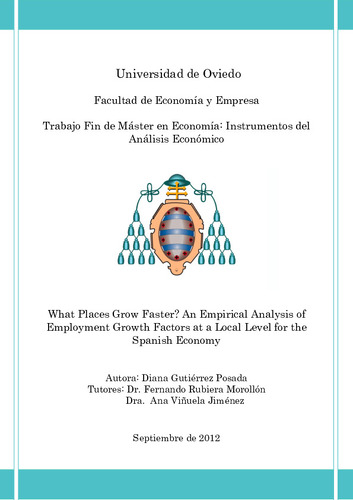What Places Grow Faster?
Otros títulos:
An Empirical Analysis of Employment Growth Factors at a Local Level for the Spanish Economy
Autor(es) y otros:
Director(es):
Palabra(s) clave:
Economía Regional
Crecimiento del Empleo Local
Mercados Locales de Trabajo
Distancias Incrementales
Políticas Locales y Regionales
España
Fecha de publicación:
Serie:
Máster Universitario en Economía: Instrumentos de Análisis Económico
Resumen:
The objective of this work is to study employment growth in Spain at a local scale. We are interested in understanding the dynamics with a high degree of spatial disaggregation. Seeing as it is impossible to obtain data on GDP or similar variables when descending to a local scale, the analysis of employment growth may serve as a proxy of local growth and provide some hints about local economic development. Using the 2001 census database, we organize the information using the methodology to define Local Labour Markets. To introduce the influence of the position of each territory regarding the main metropolitan areas we use an Incremental Distances approach, calculating the distances from each territory to different sizes of cities. Other geographical characteristics are also taken into account. The rest of the variables that will be introduced are the usual ones in macroeconomic studies, but applied at a very local level: education, diversification and sectorial structure, among others. Finally, to consider the relevance of the economic features and behaviour of the closer territories, spatial auto-regressive methods are applied. Results show that geographical variables, especially size and distances, explain many of the differences among spatial units in employment and population growth. Urban and rural areas employment is explained by different variables. The behaviour of the closer territories has a great importance too. The variables that could be affected by policies are less capable to affect employment growth tendencies.
The objective of this work is to study employment growth in Spain at a local scale. We are interested in understanding the dynamics with a high degree of spatial disaggregation. Seeing as it is impossible to obtain data on GDP or similar variables when descending to a local scale, the analysis of employment growth may serve as a proxy of local growth and provide some hints about local economic development. Using the 2001 census database, we organize the information using the methodology to define Local Labour Markets. To introduce the influence of the position of each territory regarding the main metropolitan areas we use an Incremental Distances approach, calculating the distances from each territory to different sizes of cities. Other geographical characteristics are also taken into account. The rest of the variables that will be introduced are the usual ones in macroeconomic studies, but applied at a very local level: education, diversification and sectorial structure, among others. Finally, to consider the relevance of the economic features and behaviour of the closer territories, spatial auto-regressive methods are applied. Results show that geographical variables, especially size and distances, explain many of the differences among spatial units in employment and population growth. Urban and rural areas employment is explained by different variables. The behaviour of the closer territories has a great importance too. The variables that could be affected by policies are less capable to affect employment growth tendencies.
Colecciones
- Trabajos Fin de Máster [5284]
Ficheros en el ítem





